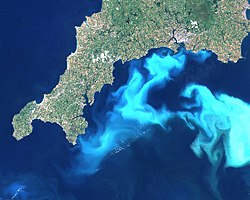Bloom in the Barents Sea
Autor:
Jeff Schmaltz
Shortlink:
Zdroj:
Formát:
4000 x 3000 Pixel (3009901 Bytes)
Popis:
Brilliant shades of blue and green explode across the Barents Sea in this natural-colour image. The color was created by a massive bloom of phytoplankton that are common in the area each August. The clear view is a rare treat since the Barents Sea is cloud-covered roughly 80 percent of the time in summer. In this image, the milky blue color strongly suggests that the bloom contains coccolithophores, microscopic plankton that are plated with white calcium carbonate. When viewed through ocean water, a coccolithophore bloom tends to be bright blue. The species is most likely Emiliana huxleyi, whose blooms tend to be triggered by high light levels during the 24-hour sunlight of Arctic summer. The variations in bloom brightness and color in satellite images is partly related to its depth: E. huxleyi, can grow abundantly as much as 50 meters below the surface. Other colors in the scene may come from sediment or other species of phytoplankton, particularly diatoms. The area in this image is located immediately north of the Scandinavian peninsula.
Licence:
Public domain
Credit:
Relevantní obrázky
Relevantní články
Emiliania huxleyiEmiliania huxleyi je jednobuněčná mořská řasa z chromist, která byla objevena krátce po roce 1950, po vynalezení elektronového mikroskopu. Do té doby byl fytoplankton viditelný pod mikroskopem jen jako slabé šmouhy. Kokolity jako první objevil Thomas Henry Huxley, který se zabýval průzkumem mořského dna a jako první použil výraz kokolit. Emiliania huxleyi byla pojmenována po něm. .. pokračovat ve čtení


